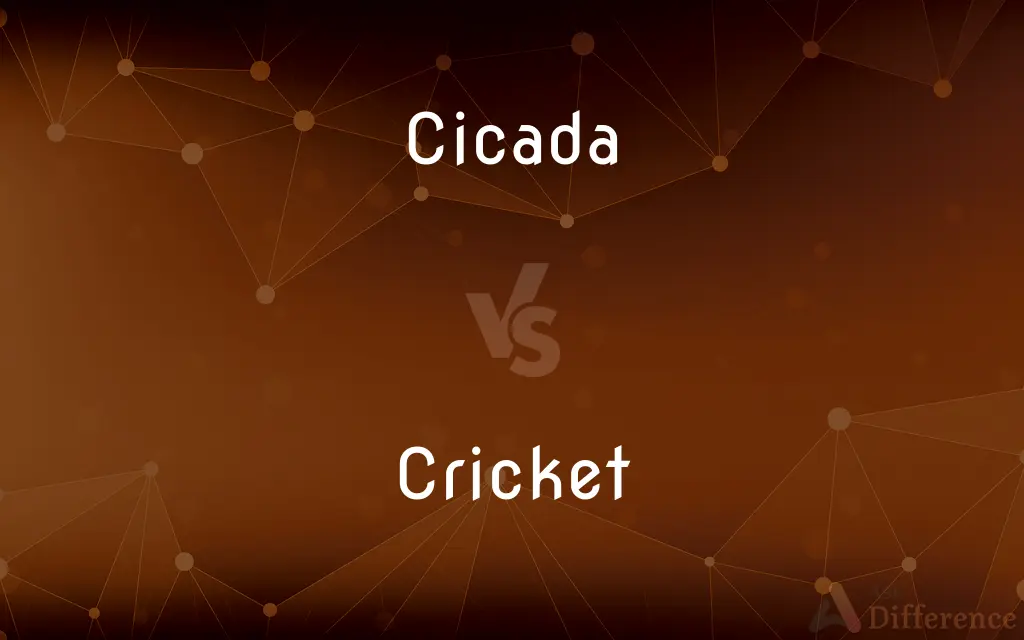Cicada vs. Cricket — What's the Difference?
Edited by Tayyaba Rehman — By Urooj Arif — Updated on March 19, 2024
Cicadas are known for their loud, distinctive songs in summer, while crickets are famous for their chirping by rubbing their wings or legs.

Difference Between Cicada and Cricket
Table of Contents
ADVERTISEMENT
Key Differences
Cicadas are large, flying insects recognized for the loud, buzzing songs produced by males to attract females. On the other hand, crickets are smaller, jumping insects with a distinctive chirping sound, produced by rubbing their wings together. Crickets are found in various habitats, including fields, forests, and inside buildings. They are omnivorous, feeding on organic materials, and are most active at night.
While cicadas are known for their periodic life cycles, especially the 13- or 17-year cycles of some species in North America, crickets have a more consistent presence, reproducing annually. Cicada emergences can lead to large swarms, creating significant noise and sometimes impacting vegetation. Crickets, though widespread and sometimes entering homes, typically do not swarm in the same noticeable way.
The cicada's song is among the loudest of all insect-produced sounds and is used as a means of communication during mating. Crickets' chirping, while also a mating call, serves additional purposes, such as establishing territory and warning off predators. The frequency of a cricket's chirp is also known to vary with temperature.
In terms of cultural significance, cicadas have been symbols of rebirth and immortality in some cultures, owing to their long underground development and sudden, mass emergence. Crickets have been seen as signs of good luck, especially in Asian cultures, and have been kept as pets for their singing.
Comparison Chart
Size and Appearance
Large, with prominent eyes and clear wings
Smaller, with long antennae and hind legs
ADVERTISEMENT
Sound Production
Tymbals on abdomen for loud buzzing
Rubbing wings together for chirping
Activity Time
Day, especially in warm weather
Night, attracted to light
Diet
Sap from plant roots, then tree fluids
Omnivorous, including plants and small insects
Cultural Significance
Symbols of rebirth and immortality
Associated with good luck and kept as pets
Ecological Role
Aerate soil, food source during emergence
Decomposers, food source for predators
Compare with Definitions
Cicada
Known for the males' distinctive mating call.
Male cicadas use their tymbals to produce a loud buzz.
Cricket
Considered a sign of good luck in some cultures.
Crickets in the house are seen as good luck in many cultures.
Cicada
A large insect known for its loud song.
The trees were alive with the sound of cicadas.
Cricket
A small, chirping insect active at night.
The sound of crickets filled the summer night.
Cicada
Insect with a lifecycle that can span over a decade.
The 17-year cicadas emerged in vast numbers.
Cricket
An important part of the food chain.
Crickets are a vital food source for nocturnal predators.
Cicada
Plays a significant role in the ecosystem.
The emergence of cicadas provides a feast for many predators.
Cricket
Known for its chirping sound made by wing-rubbing.
The cricket's chirp is a familiar sound of the countryside.
Cicada
Emerges from the ground to mate.
After 17 years underground, the cicadas finally emerged.
Cricket
Can be found in various environments.
Crickets thrive in fields, forests, and even homes.
Cicada
The cicadas ( or ) are a superfamily, the Cicadoidea, of insects in the order Hemiptera (true bugs). They are in the suborder Auchenorrhyncha, along with smaller jumping bugs such as leafhoppers and froghoppers.
Cricket
Cricket is a bat-and-ball game played between two teams of eleven players on a field at the centre of which is a 22-yard (20-metre) pitch with a wicket at each end, each comprising two bails balanced on three stumps. The batting side scores runs by striking the ball bowled at the wicket with the bat (and running between the wickets), while the bowling and fielding side tries to prevent this (by preventing the ball from leaving the field, and getting the ball to either wicket) and dismiss each batter (so they are "out").
Cicada
Any of various insects chiefly of the family Cicadidae, having a broad head, membranous wings, and in the male a pair of resonating organs that produce a characteristic high-pitched, droning sound.
Cricket
Any of various orthopteran insects of the family Gryllidae, having long antennae and legs adapted for leaping. The males of many species produce a shrill chirping sound by rubbing the front wings together.
Cicada
Any of several insects in the superfamily Cicadoidea, with small eyes wide apart on the head and transparent well-veined wings.
Cricket
(Sports) An outdoor game played with bats, a ball, and wickets by two teams of 11 players each.
Cicada
The periodical cicada.
Cricket
Good sportsmanship and fair conduct
It's not cricket to cheat at cards.
Cicada
Any species of the genus Cicada or of the family Cicadidae. They are large hemipterous insects, with nearly transparent wings. The male makes a shrill sound by peculiar organs in the under side of the abdomen, consisting of a pair of stretched membranes, acted upon by powerful muscles. A noted American species (Cicada septendecim) is called the seventeen year locust. Another common species is the dogday cicada.
Cricket
A small wooden footstool.
Cicada
Stout-bodied insect with large membranous wings; male has drum-like organs for producing a high-pitched drone
Cricket
A ridged structure made of two adjoining triangular pieces covered with flashing or roofing material and built at the upper intersection of a roof and chimney to divert water and prevent the accumulation of snow and debris. Also called saddle.
Cricket
To play the game of cricket.
Cricket
An insect in the order Orthoptera, especially family Gryllidae, that makes a chirping sound by rubbing its wing casings against combs on its hind legs.
Cricket
In the form crickets: absolute silence; no communication.
Cricket
A signalling device used by soldiers in hostile territory to identify themselves to a friendly in low visibility conditions.
Cricket
A relatively small area of a roof constructed to divert water from a horizontal intersection of the roof with a chimney, wall, expansion joint, or other projection.
Cricket
An aural warning sound consisting of a continuously-repeating chime, designed to be difficult for pilots to ignore.
Cricket
(sports) A game played outdoors with bats and a ball between two teams of eleven, popular in England and many Commonwealth countries.
Cricket
An act that is fair and sportsmanlike.
Not cricket
Cricket
A variant of the game of darts. See Cricket (darts).
Cricket
A wooden footstool.
Cricket
To play the game of cricket.
Cricket
An orthopterous insect of the genus Gryllus, and allied genera. The males make chirping, musical notes by rubbing together the basal parts of the veins of the front wings.
Cricket
A low stool.
Cricket
A game much played in England, and sometimes in America, with a ball, bats, and wickets, the players being arranged in two contesting parties or sides.
Cricket
A small false roof, or the raising of a portion of a roof, so as to throw off water from behind an obstacle, such as a chimney.
Cricket
To play at cricket.
Cricket
Leaping insect; male makes chirping noises by rubbing the forewings together
Cricket
A game played with a ball and bat by two teams of 11 players; teams take turns trying to score runs
Cricket
Play cricket
Common Curiosities
Why do cicadas make noise?
Male cicadas produce loud noises to attract females for mating purposes.
How can you tell a cicada from a cricket?
Cicadas are larger with clear wings and produce a buzzing sound, while crickets are smaller, have long antennae, and chirp by rubbing their wings.
What do crickets eat?
Crickets are omnivorous, eating plants, fungi, and occasionally small insects.
How long do crickets live?
Crickets typically live about a few months, depending on the species and environmental conditions.
Are cicadas harmful?
Cicadas are not harmful to humans but can damage young trees and plants when laying eggs.
Why do crickets chirp at night?
Crickets chirp at night for mating purposes and to establish territory, utilizing the cooler, quieter nighttime environment.
Can crickets fly?
Some cricket species can fly short distances, but many are more adept at jumping.
How do cicadas survive underground?
Cicada nymphs feed on sap from plant roots while underground, which sustains them through their developmental stages.
Can you eat cicadas and crickets?
Yes, both cicadas and crickets are edible and are considered delicacies in some cultures, known for their protein content.
What is the significance of cicada emergences?
Cicada emergences, especially the periodic ones, are significant ecological events, providing a massive food source for predators and stimulating the ecosystem.
What attracts crickets to houses?
Crickets are attracted to warm, moist environments and can enter homes in search of food.
Why are crickets considered good luck?
In many cultures, crickets are considered symbols of good fortune and prosperity, and their presence is welcomed.
How often do cicadas emerge?
Some cicada species emerge annually, while others, known as periodical cicadas, emerge every 13 or 17 years.
Do cicadas bite or sting?
Cicadas do not bite or sting. They are harmless to humans.
Share Your Discovery

Previous Comparison
Robe vs. Cloak
Next Comparison
Phenylalanine vs. TyrosineAuthor Spotlight
Written by
Urooj ArifUrooj is a skilled content writer at Ask Difference, known for her exceptional ability to simplify complex topics into engaging and informative content. With a passion for research and a flair for clear, concise writing, she consistently delivers articles that resonate with our diverse audience.
Edited by
Tayyaba RehmanTayyaba Rehman is a distinguished writer, currently serving as a primary contributor to askdifference.com. As a researcher in semantics and etymology, Tayyaba's passion for the complexity of languages and their distinctions has found a perfect home on the platform. Tayyaba delves into the intricacies of language, distinguishing between commonly confused words and phrases, thereby providing clarity for readers worldwide.











































